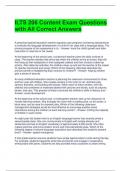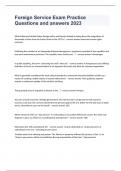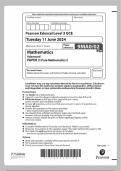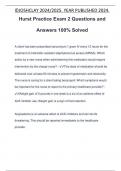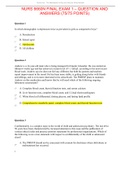with All Correct Answers
A preschool special education teacher regularly uses progress monitoring assessments
to evaluate the language development of a child in her class with a language delay. The
primary purpose of this assessment is to: - Answer- track the child's growth and tailor
instruction to meet his or her needs
At the beginning of the school year, a preschool teacher plans the daily routines of
class. The teacher decides that every day when the children arrive at school, they will
first hang up their backpacks in their assigned cubbies and then choose a table top
activity. After table top activities, the children clean up and join the teacher at the carpet
for teacher-led stories and songs. Which of the following rationales describes the
primary benefit of establishing daily routines for children? - Answer- helping children
gain a sense of security
An early childhood education teacher is planning the classroom environment for three
and four year old children. She creates centers in the room for art, dramatic play,
sensory activities, and building with blocks. Within each of these centers, she has
shelves and containers of materials labeled with pictures and words, such as crayons,
blocks, and cars. This practice is likely to promote the children's skills in literacy and: -
Answer- social development
At the beginning of the school year, a kindergarten teacher sets up her classroom to
include learning centers. She arranges her room with a reading area, an art center, a
block area, and an area for dramatic play. Which of the following classroom
management strategies would be most effective to encourage positive social
interactions among the children at each learning center? - Answer- limiting the capacity
of children in each center
An eight year old student who is an English language learner has recently joined a
second-grade class. She can communicate in English with simple phrases and
sentences and has an English vocabulary of approximately 3,000 words. She often
makes grammar and pronunciation errors and misunderstands jokes. Which of the
following stages of second language acquisition best describes this student's present
level? - Answer- speech emergence
A first-grade teacher ensures students have ample opportunities to write during the day.
For example, students frequently write lists and stories and engage in cooperative
writing tasks with peers. Students are also provided many occasions to share writing
, with the class. In addition to promoting students' writing development, the teacher's
regular use of these activities most likely directly builds students'. - Answer- reading
skills by reinforcing their understanding of the relationship between sounds and letters
An early childhood teacher works in a day-care center. She sits on the floor to play with
a nine-month-old infant who is interested in a bucket of plastic blocks that can easily
stacked together. Which of the following teacher actions would best engage the infant
and encourage communication? - Answer- talking about the blocks as the infant plays
with them
A kindergarten teacher reads the following set of four words: bet, bat, bug, cap to a
small group of children. The teacher asks the children to identify which word doesn't
belong in the group. Which of the following areas of phonemic awareness does this
activity promote? - Answer- phoneme categorization
During an informal assessment, a kindergarten teacher asks a child to demonstrate
what he knows about books. The child points at words on the front cover and says, "I
can read it like this." Holding the book correctly, the child opens the cover and begins
telling a story while pointing to words on the pages. On the last page the child says, "the
end". The child's actions suggest that he is beginning to understand: - Answer- concept
about print
Which of the following skills is a child able to demonstrate if they have developed the
most complex level of phonological awareness? - Answer- segmenting individual
sounds in words
A teacher uses the following graphic organizer with her second-grade class during a
vocabulary lesson. - Answer- requiring students to generate various uses of a word
A second-grade teacher notes that a student takes longer than average to read various
grade-level texts. The student sounds choppy when reading aloud and rarely reads in
phrases or with proper intonation. These factors will most directly affect the student's: -
Answer- reading comprehension
A second-grade teacher is planning a lesson to teach students how to use nonfiction
text features to help them locate and use information to answer questions. The teacher
considers selecting various nonfiction texts that can specifically promote students'
abilities to identify main topics while skimming through the text. To best serve the
lesson's purpose, the teacher should choose a nonfiction text that has: - Answer-
headings and subheadings
A first-grade teacher will read aloud a story about types of transportation. The students
will then answer comprehension questions about the story. Which of the following
should the teacher do first before reading the story to the class? - Answer- ensuring with
the students have an understanding of types of transportation

